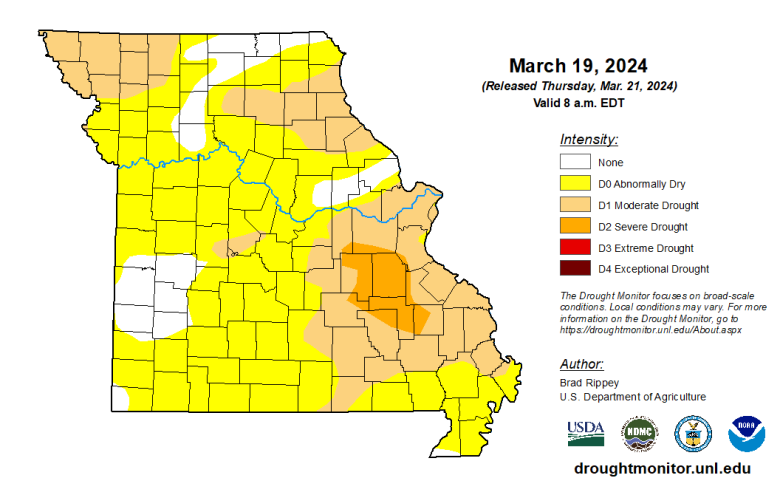Early spring drought conditions in Missouri, Kansas


JOPLIN, Mo. — Drought conditions across southwest Missouri and southeast Kansas are improving after a year where much of the region was plagued with moderate to severe drought.
The latest drought information for southwest Missouri shows most of the region as abnormally dry. The majority of the “Show-Me State” falls under the D0 drought intensity category.
Several southwest Missouri counties are not reporting any drought conditions. This includes Interstate 49 and portions west in McDonald County. Meteorologist Ray Foreman says the most recent drought report is good news for area farmers.
“Missouri, southeast Kansas, and northeast Oklahoma — we’re in a lot better shape than we were even a month ago. We’re what’s considered abnormally dry. One good thing about where we’re sitting right now, with the recent rainfall in areas such as Greenfield, Golden City, Stockton and Nevada, they’re not under any drought condition at all. So the fields here are looking good right now,” says Foreman.

| Hummingbirds Now Migrating Back To The Midwest >
In Kansas, the latest Drought Monitor shows similar conditions. However, there are a few counties such as Montgomery, Wilson, Neosho, Elk, and Chautauqua Counties experiencing moderate drought. A majority of Chautauqua County is currently under severe drought conditions.
“In southeast Kansas, specifically areas to the west and southwest of Columbus around the Verdigris River, those areas could use some more rain, but a lot of that runoff comes from central parts of Kansas and that can swing one way or the other very quickly,” says Foreman.

| The Reality Of Being Struck By Lightning While Indoors >
For much of 2023, particularly during the late summer, both Missouri and Kansas experienced several prolonged periods of severe and extreme drought. However, those extreme conditions eased during the winter months of 2023-2024.
“We’ve actually had some pretty decent rainfalls over the last two months, so that has really helped. We didn’t get a lot of snow this winter, but we got enough that it was able to slowly seep into the ground and help improve our drought conditions,” says Foreman.
According to Foreman, conditions can and do change — sometimes considerably — from one issued U.S. Drought Monitor to the next.
“These conditions change quite frequently. I’ve heard several farmers say, ‘we’re never more than 10 days away from a drought,’ and that’s simply because if we don’t get any rain anywhere from 10 days up to a two-week period, then things will dry out quickly,” says Foreman.
According to the Climate Prediction Center, southwest Missouri, southeast Kansas and the Four State region all have equal chances for below/above normal temperatures for the next three months. During this timeframe, chances lean towards above normal precipitation.
“As long as we don’t get the heavy downpours where it just runs off all the time, and then it’s gone. It’d be a lot better if we could get some more consistent and persistent rain. If you get several periods of heavy downpours, then you go toward the other extreme — that’s where it’s too wet for the farmers to get out into the fields and do any work,” says Foreman.
The U.S. Drought Monitor is produced jointly by the National Drought Mitigation Center at the University of Nebraska-Lincoln, the National Oceanic and Atmospheric Administration, and the U.S. Department of Agriculture.

